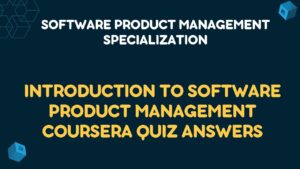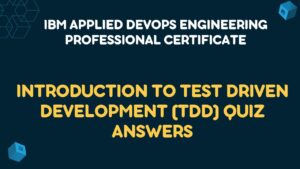Table of Contents
Building AI Powered Chatbots Without Programming Week 01 Quiz Answers
Module 1 Quiz: Introduction
Q1. A chatbot will typically interact with the user via text or audio.
- True
- False
Q2. A chatbot is a bot that interacts with the user through a chat/conversational interface.
- True
- False
Q3. Chatbots are also known as
- Artificial Conversational Entities (ACE)
- Talkbots
- Virtual Assistants
- Chatterbots
Q4. What factors directly contributed to the emergence of chatbots?
- Blockchain
- Ruby on Rails
- Messaging platforms like Facebook Messenger
- AI / Cognitive Computing
Q5. Chatbots are only beneficial to large companies.
- True
- False
Module 2 Quiz: Intents
Q1. Watson Assistant (formerly Conversation) can only be used to create chatbots in English.
- True
- False
Q2. Select all the statements that are true.
- Intents can have spaces in their names
- We should provide Watson with at least 5 examples per intent
- Intents start with an # symbol
- We train Watson by providing examples for our intents
- An intent is a purpose or goal expressed by the user’s input
Q3. The three main components of a Dialog Skill are Intents, Entities, and Dialog.
- True
- False
Q4. If Watson detects the wrong intent, we can train Watson by selecting a different intent from the Try it out panel.
- True
- False
Q5. The Content Catalog offers collections of pre-made intents for various industries.
- True
- False
Building AI Powered Chatbots Without Programming Week 02 Quiz Answers
Module 3 Quiz: Entities
Q1. Entities allow us to capture specific information in the user input
- True
- False
Q2. Entities start with an # symbol
- True
- False
Q3. Entity values can have synonyms and patterns
- True
- False
Q4. Two user questions can have the same intent but different entity values.
- True
- False
Q5. In our flower shop chatbot, “dad” is defined as a synonym for @relationship:father. If the user enters “which flowers for dad”, what’s the entity value detected by Watson?
- @relationship:dad
- @relationship:father
- @dad
- @flower_suggestions
- @relationship
Module 4 Quiz: Dialog
Q1. Multiple conditional responses allow us to attach conditions to responses within a node.
- True
- False
Q2. The order of nodes in the dialog can affect how the chatbot works.
- True
- False
Q3. Node A has @occasion as its condition. Node B, placed just below node A, has @occasion:Graduation as its condition. Which of the following statements is true?
- The order of node A and node B doesn’t matter.
- Both node A and node B will never be executed.
- Node A is overshadowed and will not be executed (unless we explicitly jump to it).
- Node B is overshadowed and will not be executed (unless we explictily jump to it).
Q4. In general, child nodes are considered if the parent node condition is met.
- True
- False
Q5. Select all the statements that are true.
- The tone and personality of our chatbot can affect how well it is perceived by the user.
- Chatbot prompts should be as generic as possible (e.g., Hello. Ask me anything.)
- Very long responses are good
- When designing a chatbot, we should consider tone and personality.
- We should avoid “yes” and “no” answers when possible
Building AI Powered Chatbots Without Programming Week 03 Quiz Answers
Module 5 Quiz: Deployment
Q1. The Watson Assistant (formerly Conversation) plugin for WordPress allows us to deploy a chatbot by specifying the credentials of the corresponding Assistant, without the need to develop a separate, proxy application.
- True
- False
Q2. A preview link integration allows us to share our chatbot with friends and colleagues.
- True
- False
Q3. One or more skills can be linked to an Assistant. In other words, an Assistant can “contain” one or more skills
- True
- False
Q4. The WordPress plugin for Watson Assistant allow us to customize the look and feel of the chat box that appears on the site
- True
- False
Q5. There is no way to limit the chatbot usage in the Watson Assistant WordPress plugin (to prevent abusive users).
- True
- False
Module 6 Quiz: Context Variables & Slots
Q1. Once set, context variables can be accessed for the duration of the conversation with a given user.
- True
- False
Q2. Slots allow us to collect information from the user and store it in context variables.
- True
- False
Q3. Slots with no question defined are optional and will only set the context variable if the condition (e.g., @location) is detected.
- True
- False
Q4. A node can only have one slot and therefore cannot assign more than one context variable.
- True
- False
Q5. In general, a required slot will only ask its question to the user once, even if the user replies with irrelevant information.
- True
- False
Building AI Powered Chatbots Without Programming Week 04 Quiz Answers
Module 7 Quiz: Digressions
Q1. The “Found” section of a slot allow us to specify what to say to the user (e.g., thanking them) when they provide a valid reply to the slot.
- True
- False
Q2. The “Not Found” section of a slot allow us to specify what to say to the user when they provide an invalid reply to the slot (e.g., a reply that doesn’t meet the slot condition).
- True
- False
Q3. Digressions allows us to decide what the chatbot should do when the user asks a different question instead of replying to the slot question.
- True
- False
Q4. Handlers are evaluated after the “Not found” responses you defined in a slot.
- True
- False
Q5. We must explicitly enable returns to a slot to continue where we left off before a digression.
- True
- False
Get all Course Quiz Answers of IBM Applied AI Professional Certificate
Introduction to Artificial Intelligence (AI) Coursera Quiz Answers
Getting Started with AI using IBM Watson Coursera Quiz Answers
Building AI Powered Chatbots Without Programming Quiz Answers
Python for Data Science, AI & Development Coursera Quiz Answers
Python Project for AI & Application Development Coursera Quiz Answers
Building AI Applications with Watson APIs Coursera Quiz Answers




